Indirect Thermographic Temperature Measurement of a Power Rectifying Diode Die under Forced Convection Conditions
Abstract
1. Introduction
- -
- Methods based on thermal sensitive parameter (TSP);
- -
- Methods which use contact sensors;
- -
- Methods which use non-contact sensors.
2. Materials and Methods
2.1. Measurement System and Equipment
2.2. Determining Convection Coefficients and Simulation Boundary Conditions
3. Results
4. Discussion
5. Conclusions
Author Contributions
Funding
Institutional Review Board Statement
Informed Consent Statement
Data Availability Statement
Conflicts of Interest
Nomenclatures
| Tj | junction temperature |
| VF | forward voltage |
| IF | forward current |
| λ | wavelength |
| ε | emissivity factor |
| p | reflectance factor |
| c | specific heat |
| d | density |
| kx, ky and kz | thermal conductivities in the directions x, y, and z directions |
| T | temperature |
| t | time |
| J | radiative heat flux |
| Pc | total power |
| S | the area of the flat wall, which was penetrated by J |
| i | node number |
| Hi | linear shape function |
| hr | radiation coefficient |
| σc | Stefan–Boltzmann constant |
| Ta | air temperature |
| TS | surface temperature |
| hc | convection coefficient of flat surfaces |
| Nu | Nusselt number |
| L | characteristic length |
| Pr | Prandtl number |
| Re | Reynolds number |
| C, a, b | coefficients depend on surface orientation (horizontal/vertical) |
| η | dynamic air viscosity |
| V | average linear velocity of fluid flow |
| hcr | convection coefficient for roller surface |
| d | dimension of roller |
| ρ | air density equal |
| k | thermal conductivity |
| TSym | results obtained simulation |
| TC | results obtained from thermographic measurement |
References
- Senturk, O.S.; Helle, L.; Munk-Nielsen, S.; Rodriguez, P.; Teodorescu, R. Converter structure-based power loss and static thermal modeling of the press-pack IGBT three-level ANPC VSC applied to multi-MW wind turbines. IEEE Trans. Ind. Appl. 2011, 47, 2505–2515. [Google Scholar] [CrossRef]
- Nakamura, Y. Electrothermal Cosimulation for Predicting the Power Loss and Temperature of SiC MOSFET Dies Assembled in a Power Module. IEEE Trans. Power Electron. 2020, 35, 2950–2958. [Google Scholar] [CrossRef]
- Amiri, P.; Eberle, D.; Gautam, D.; Botting, C.A. CCM Bridgeless Single-Stage Soft-Switching AC-DC Converter for EV Charging Application. In Proceedings of the 2021 IEEE Energy Conversion Congress and Exposition (ECCE), Vancouver, BC, Canada, 10–14 October 2021; pp. 1846–1852. [Google Scholar] [CrossRef]
- Ciappa, M.; Fichtner, W.; Kojima, T.; Yamada, Y.; Nishibe, Y. Extraction of accurate thermal compact models for fast electro-thermal simulation of IGBT modules in hybrid electric vehicles. Microelectron. Reliab. 2005, 45, 1694–1699. [Google Scholar] [CrossRef]
- Gorji, S.A.; Sahebi, H.G.; Ektesabi, M.; Rad, A.B. Topologies and control schemes of bidirectional DC–DC power converters: An overview. IEEE Access 2019, 7, 117997–118019. [Google Scholar] [CrossRef]
- Busatto, T.; Rönnberg, S.K.; Bollen, M.H.J. Comparison of Models of Single-Phase Diode Bridge Rectifiers for Their Use in Harmonic Studies with Many Devices. Energies 2022, 15, 66. [Google Scholar] [CrossRef]
- D61-200-22-NO-ABG. Available online: https://www.poweralia.com/d61-200-22-n0-abg-pw (accessed on 14 February 2023).
- SCDR0240N12M. Available online: https://www.poweralia.com/scdr0240n12m-pw (accessed on 14 February 2023).
- Dziarski, K.; Hulewicz, A.; Dombek, G.; Drużyński, Ł. Indirect Thermographic Temperature Measurement of a Power-Rectifying Diode Die. Energies 2022, 15, 3203. [Google Scholar] [CrossRef]
- Plesca, A.; Mihet-Popa, L. Thermal Analysis of Power Rectifiers in Steady-State Conditions. Energies 2020, 13, 1942. [Google Scholar] [CrossRef]
- Hayashi, Y.; Takao, K.; Adachi, K.; Ohashi, H. Design consideration for high output power density (OPD) converter based on power-loss limit analysis method. In Proceedings of the 2005 European Conference on Power Electronics and Applications, Dresden, Germany, 11–14 September 2005; IEEE: Piscataway, NJ, USA, 2005; pp. 1–9. [Google Scholar] [CrossRef]
- Li, X.; Li, D.; Qi, F.; Packwood, M.; Luo, H.; Liu, G.; Dai, X. Advanced Electro-Thermal Analysis of IGBT Modules in a Power Converter System. In Proceedings of the 2019 20th International Conference on Thermal, Mechanical and Multi-Physics, Hannover, Germany, 24–27 March 2019; IEEE: Piscataway, NJ, USA, 2019; pp. 1–4. [Google Scholar] [CrossRef]
- Kasprzak, M.; Sledzinska, M.; Zaleski, K.; Iatsunskyi, I.; Alzina, F.; Volz, S.; Torres, C.M.S.; Graczykowski, B. High-temperature silicon thermal diode and switch. Nano Energy 2020, 78, 105261. [Google Scholar] [CrossRef]
- Ostapchuk, M.; Shishov, D.; Shevtsov, D.; Zanegin, S. Research of Static and Dynamic Properties of Power Semiconductor Diodes at Low and Cryogenic Temperatures. Inventions 2022, 7, 96. [Google Scholar] [CrossRef]
- Teo, J.C.; Tan, R.H.G.; Mok, V.H.; Ramachandaramurthy, V.K.; Tan, C. Impact of bypass diode forward voltage on maximum power of a photovoltaic system under partial shading conditions. Energy 2020, 191, 116491. [Google Scholar] [CrossRef]
- Available online: https://www.jedec.org/ (accessed on 14 February 2023).
- Leonidas, E.; Ayvar-Soberanis, S.; Laalej, H.; Fitzpatrick, S.; Willmott, J.R. A Comparative Review of Thermocouple and Infrared Radiation Temperature Measurement Methods during the Machining of Metals. Sensors 2022, 22, 4693. [Google Scholar] [CrossRef]
- Shariq, M.; Asim Siddiqui, M.; Qamar, M.A.; Altowairqi, Y.; Ali, S.K.; Madkhali, O.; Fadhali, M.M.; Alharbi, T.; Khan, M.S.; Saheb Syed, I.; et al. Study of Co-Doped K2Ti6O13 Lead-Free Ceramic for Positive Temperature Coefficient Thermistor Applications. Crystals 2022, 12, 1569. [Google Scholar] [CrossRef]
- Zhang, H.; Teoh, J.C.; Wu, J.; Yu, L.; Lim, C.T. Dynamic Zero Current Method to Reduce Measurement Error in Low Value Resistive Sensor Array for Wearable Electronics. Sensors 2023, 23, 1406. [Google Scholar] [CrossRef] [PubMed]
- Wang, F.; Lin, Z.; Zhang, Z.; Li, Y.; Chen, H.; Liu, J.; Li, C. Fabrication and Calibration of Pt-Rh10/Pt Thin-Film Thermocouple. Micromachines 2023, 14, 4. [Google Scholar] [CrossRef] [PubMed]
- Zaccara, Z.; Edelman, J.B.; Cardone, G. A general procedure for infrared thermography heat transfer measurements in hypersonic wind tunnels. Int. J. Heat Mass Transf. 2020, 163, 120419–120435. [Google Scholar] [CrossRef]
- Altenburg, J.S.; Straße, A.; Gumenyuk, A.; Meierhofer, C. In-situ monitoring of a laser metal deposition (LMD) process: Comparison of MWIR, SWIR and high-speed NIR thermography. Quant. InfraRed Thermogr. J. 2020, 19, 97–114. [Google Scholar] [CrossRef]
- Yoon, S.T.; Park, J.C. An experimental study on the evaluation of temperature uniformity on the surface of a blackbody using infrared cameras. Quant. InfraRed Thermogr. J. 2021, 19, 172–186. [Google Scholar] [CrossRef]
- Schuss, C.; Remes, K.; Leppänen, K.; Saarela, J.; Fabritius, T.; Eichberger, B.; Rahkonen, T. Detecting Defects in Photovoltaic Cells and Panels with the Help of Time-Resolved Thermography under Outdoor Environmental Conditions. In Proceedings of the 2020 IEEE International Instrumentation and Measurement Technology Conference (I2MTC), Dubrovnik, Croatia, 25–28 May 2020; pp. 1–6. [Google Scholar] [CrossRef]
- Chakraborty, B.; Billol, K.S. Process-integrated steel ladle monitoring, based on infrared imaging—A robust approach to avoid ladle breakout. Quant. InfraRed Thermogr. J. 2020, 17, 169–191. [Google Scholar] [CrossRef]
- Tomoyuki, T. Coaxiality Evaluation of Coaxial Imaging System with Concentric Silicon–Glass Hybrid Lens for Thermal and Color Imaging. Sensors 2020, 20, 5753. [Google Scholar] [CrossRef]
- Wollack, J.E.; Cataldo, G.; Miller, K.H.; Quijada, A.M. Infrared properties of high-purity silicon. Opt. Lett. 2020, 45, 4935–4938. [Google Scholar] [CrossRef]
- Singh, J.; Arora, A.S. Effectiveness of active dynamic and passive thermography in the detection of maxillary sinusitis. Quant. InfraRed Thermogr. J. 2020, 18, 213–225. [Google Scholar] [CrossRef]
- Dziarski, K.; Hulewicz, A.; Dombek, G. Lack of Thermogram Sharpness as Component of Thermographic Temperature Measurement Uncertainty Budget. Sensors 2021, 21, 4013. [Google Scholar] [CrossRef]
- Dziarski, K.; Hulewicz, A.; Dombek, G. Thermographic Measurement of the Temperature of Reactive Power Compensation Capacitors. Energies 2021, 14, 5736. [Google Scholar] [CrossRef]
- Xu, J.; Wang, X.; Shi, H.; Mei, X. Multi-scale short circuit resistance estimation method for series connected battery strings. Energy 2020, 202, 117647. [Google Scholar] [CrossRef]
- Valdivieso, C.A.; Meunier, G.; Ramdane, B.; Gyselinck, J.; Guerin, C.; Sabariego, R.V. Time-Domain Finite-Element Eddy-Current Homogenization of Windings Using Foster Networks and Recursive Convolution. IEEE Trans. Magn. 2020, 56, 7401408. [Google Scholar] [CrossRef]
- Sato, Y.; Shimotani, T.; Igarashi, H. Synthesis of Cauer-Equivalent Circuit Based on Model Order Reduction Considering Nonlinear Magnetic Property. IEEE Trans. Magn. 2017, 53, 1100204. [Google Scholar] [CrossRef]
- Optris XI 400. Available online: https://www.optris.global/optris-xi-400?gclid=CjwKCAiAoL6eBhA3EiwAXDom5iDyJ7ANskvy59t3eZIY5ngbPO7LCh2NPJaQ94OcHAQARnbD_K9rxxoCSbkQAvD_BwE (accessed on 24 January 2023).
- Krawiec, P.; Rózański, L.; Czarnecka-Komorowska, D.; Warguła, Ł. Evaluation of the Thermal Stability and Surface Characteristics of Thermoplastic Polyurethane V-Belt. Materials 2020, 7, 1502. [Google Scholar] [CrossRef] [PubMed]
- Kawor, E.T.; Mattei, S. Emissivity measurements for nexel velvet coating 811-21 between −36 °C and 82 °C. High Temp. High Press. 1999, 33, 551–556. [Google Scholar] [CrossRef]
- Li, H. The Finite Element Method. In Graded Finite Element Methods for Elliptic Problems in Nonsmooth Domains; Surveys and Tutorials in the Applied Mathematical Sciences; Springer: Cham, Switzerland, 2022; Volume 10. [Google Scholar] [CrossRef]
- Feng, S.Z.; Cui, X.Y.; Li, G.Y. Transient thermal mechanical analyses using a face-based smoothed finite element method (FS-FEM). Int. J. Therm. Sci. 2013, 74, 95–103. [Google Scholar] [CrossRef]
- Devloo, P.R.B.; Bravo, C.M.A.A.; Rylo, E.C. Systematic and generic construction of shape functions for p-adaptive meshes of multidimensional finite elements. Comput. Methods Appl. Mech. Eng. 2009, 198, 1716–1725. [Google Scholar] [CrossRef]
- Dziarski, K.; Hulewicz, A.; Drużyński, Ł.; Dombek, G. Indirect Thermographic Temperature Measurement of a Power-Rectifying Diode Die Based on a Heat Sink Thermogram. Energies 2023, 16, 332. [Google Scholar] [CrossRef]
- Ghahfarokhi, P.S. Determination of Forced Convection Coefficient over a Flat Side of Coil. In Proceedings of the 2017 IEEE 58th International Scientific Conference on Power and Electrical Engineering of Riga Technical University (RTUCON), Riga, Latvia, 12–13 October 2017. [Google Scholar] [CrossRef]
- Aminu, Y.; Ballikaya, S. Thermal resistance analysis of trapezoidal concentrated photovoltaic–Thermoelectric systems. Energy Convers. Manag. 2021, 250, 114908. [Google Scholar] [CrossRef]
- Available online: https://repozytorium.biblos.pk.edu.pl/redo/resources/30992/file/suwFiles/DudaP_WyznaczanieWspolczynnika.pdf (accessed on 14 February 2023).
- Available online: https://www.sciencedirect.com/science/article/pii/S0038092X05003701 (accessed on 14 February 2023).
- Poppe, A.; Farkas, G.; Gaál, L.; Hantos, G.; Hegedüs, J.; Rencz, M. Multi-Domain Modelling of LEDs for Supporting Virtual Prototyping of Luminaires. Energies 2019, 12, 1909. [Google Scholar] [CrossRef]
- Available online: https://www.sciencedirect.com/science/article/pii/S0017931018362045 (accessed on 15 February 2023).
- Kosmol, J. Modeling of Heat Phenomenon in Rolling Kinematic Pairs Using the Finite Element Method. Appl. Sci. 2021, 11, 6447. [Google Scholar] [CrossRef]
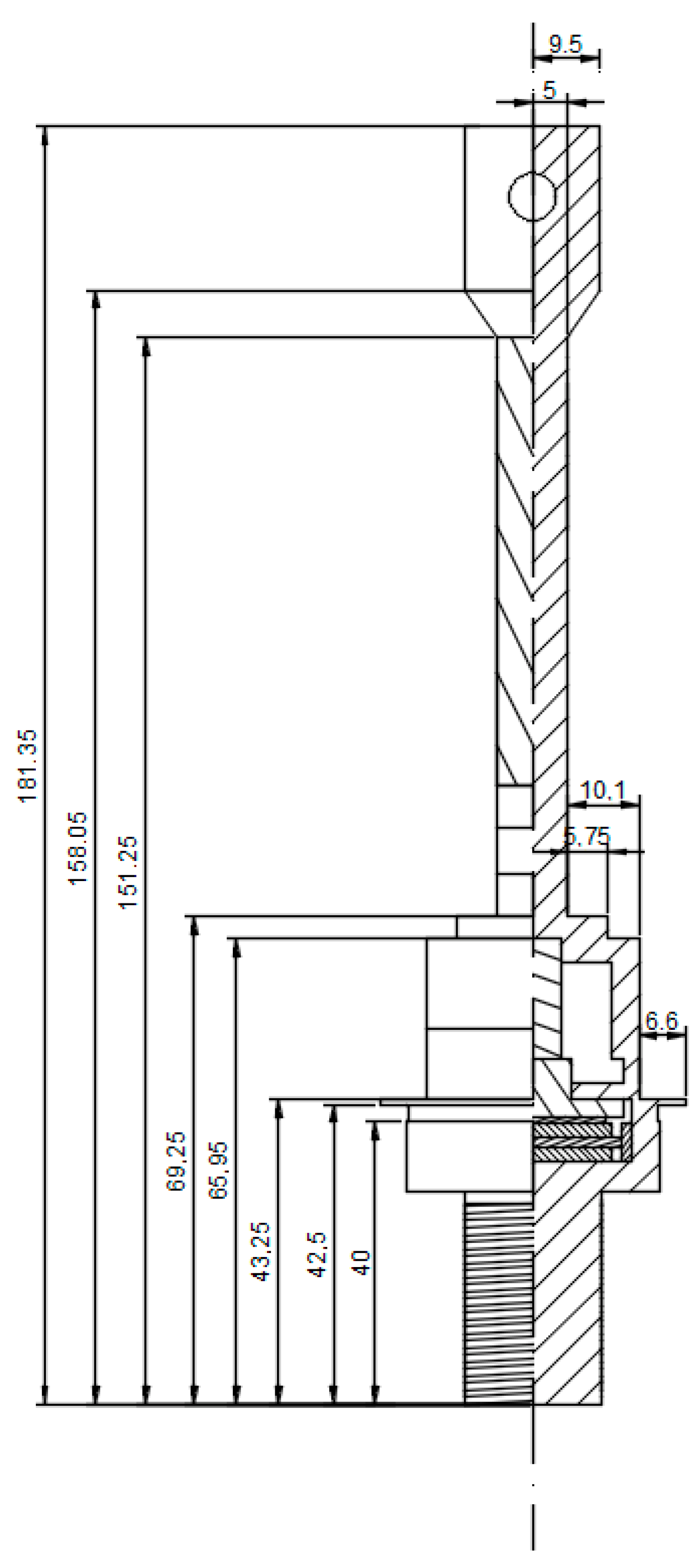
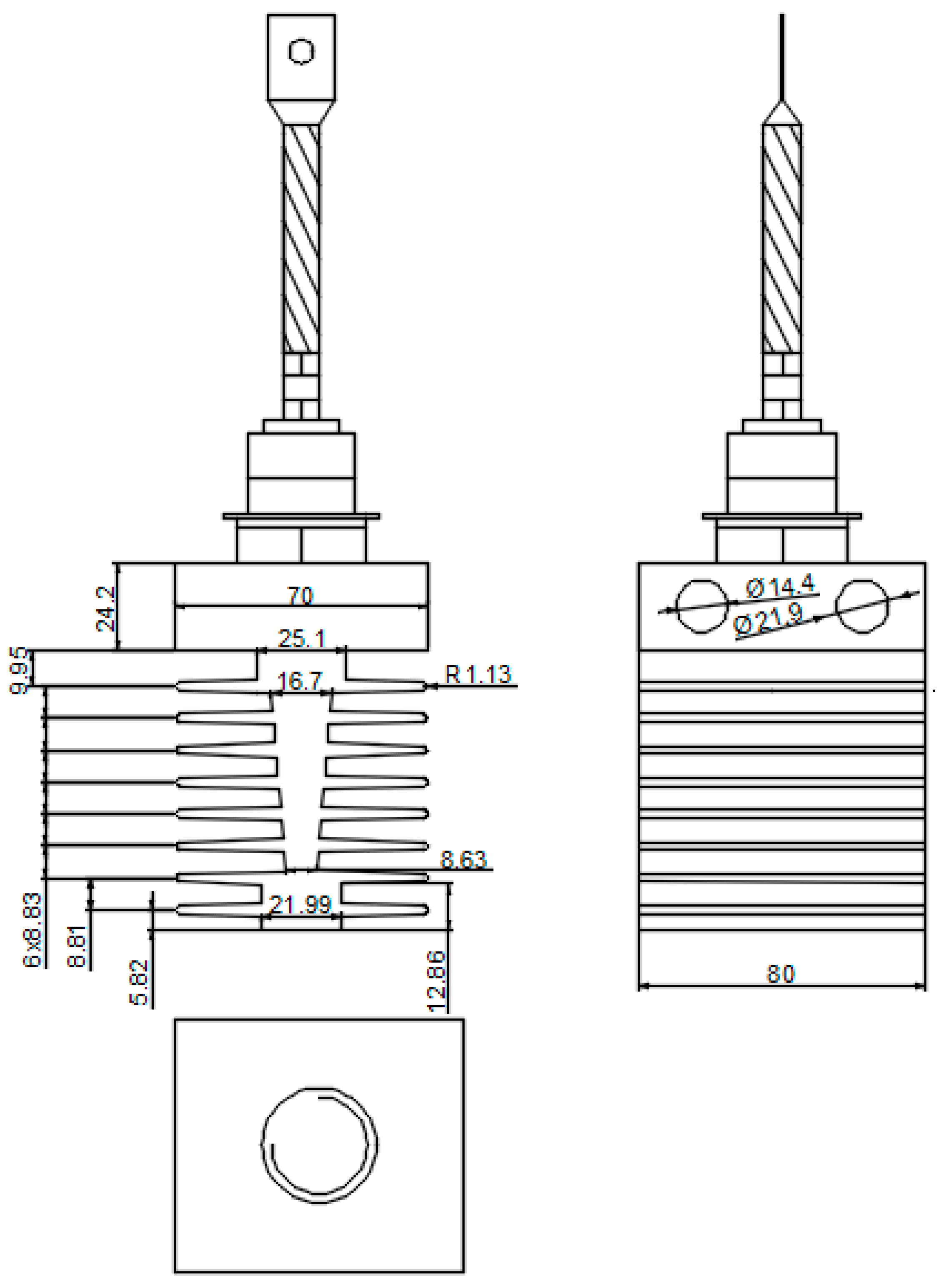
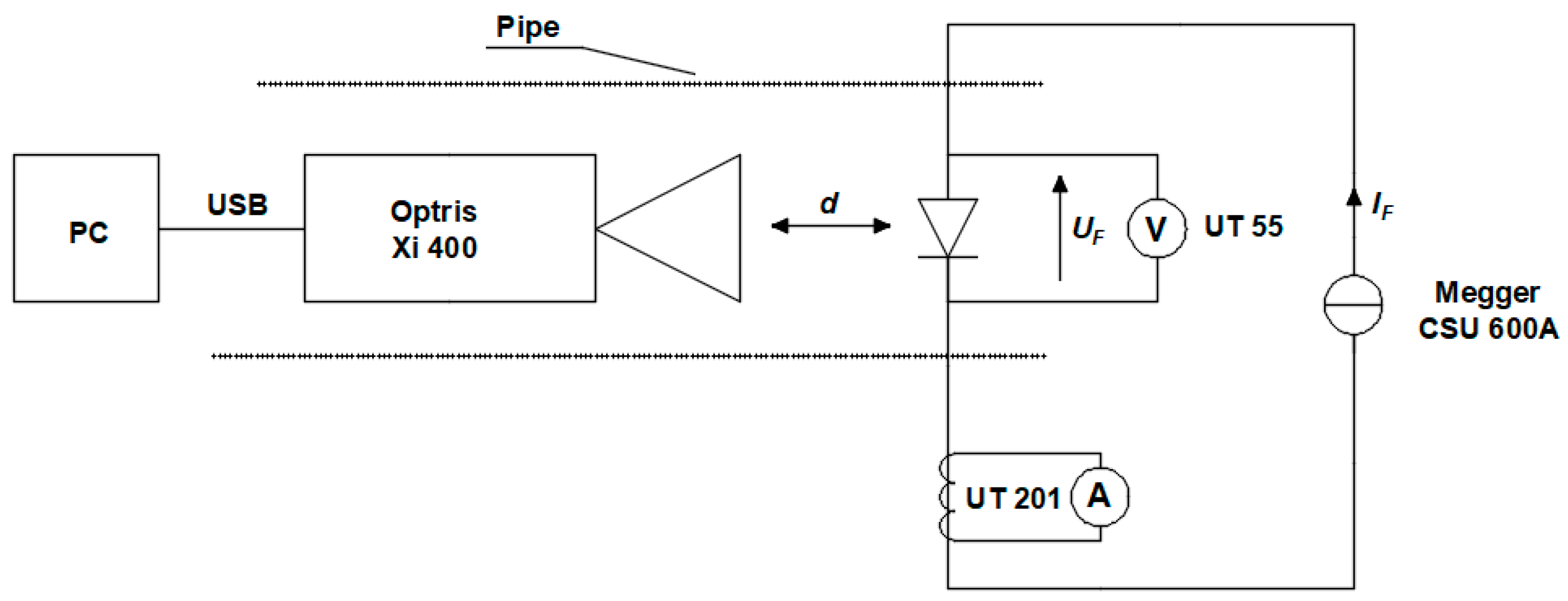
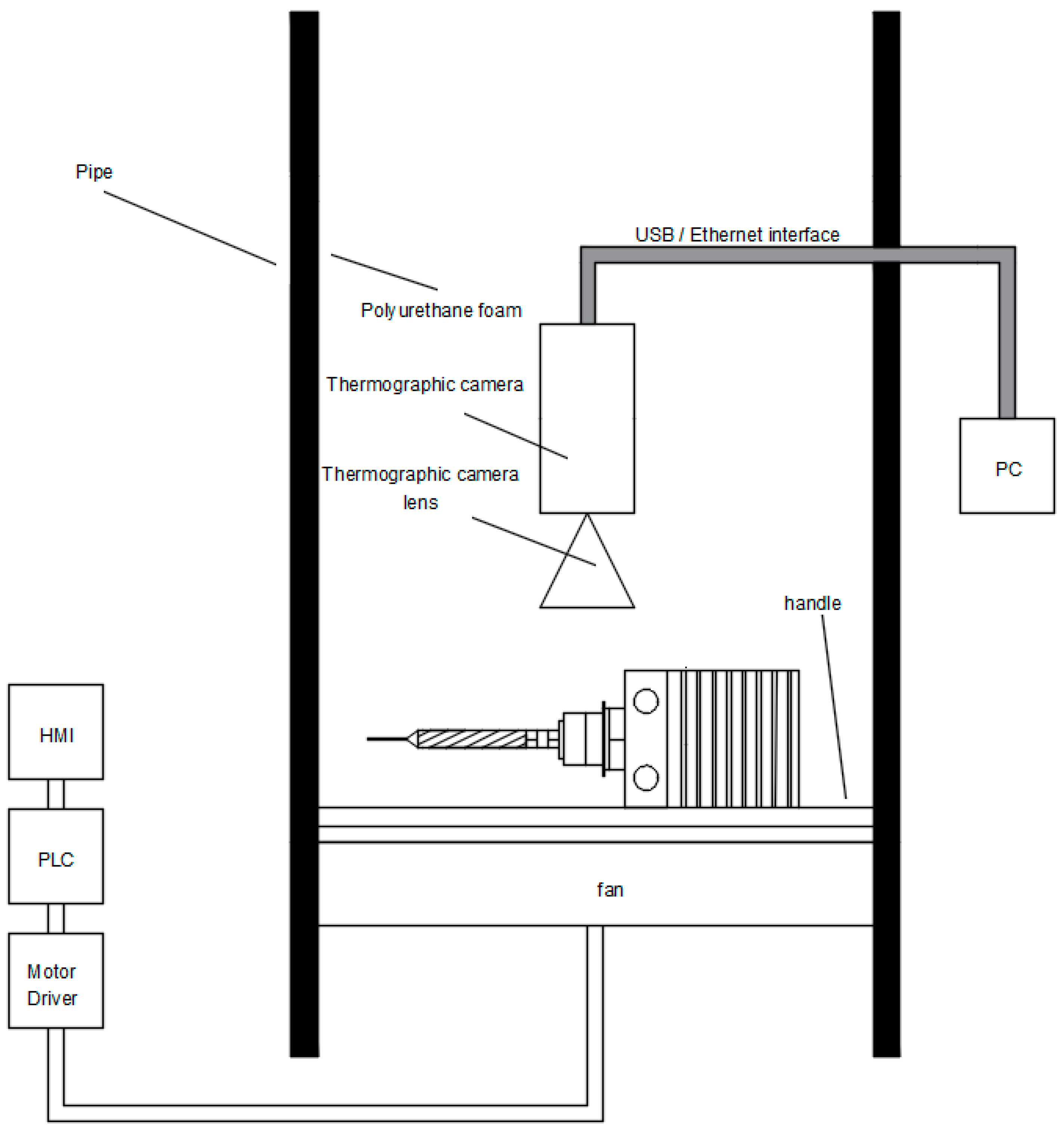
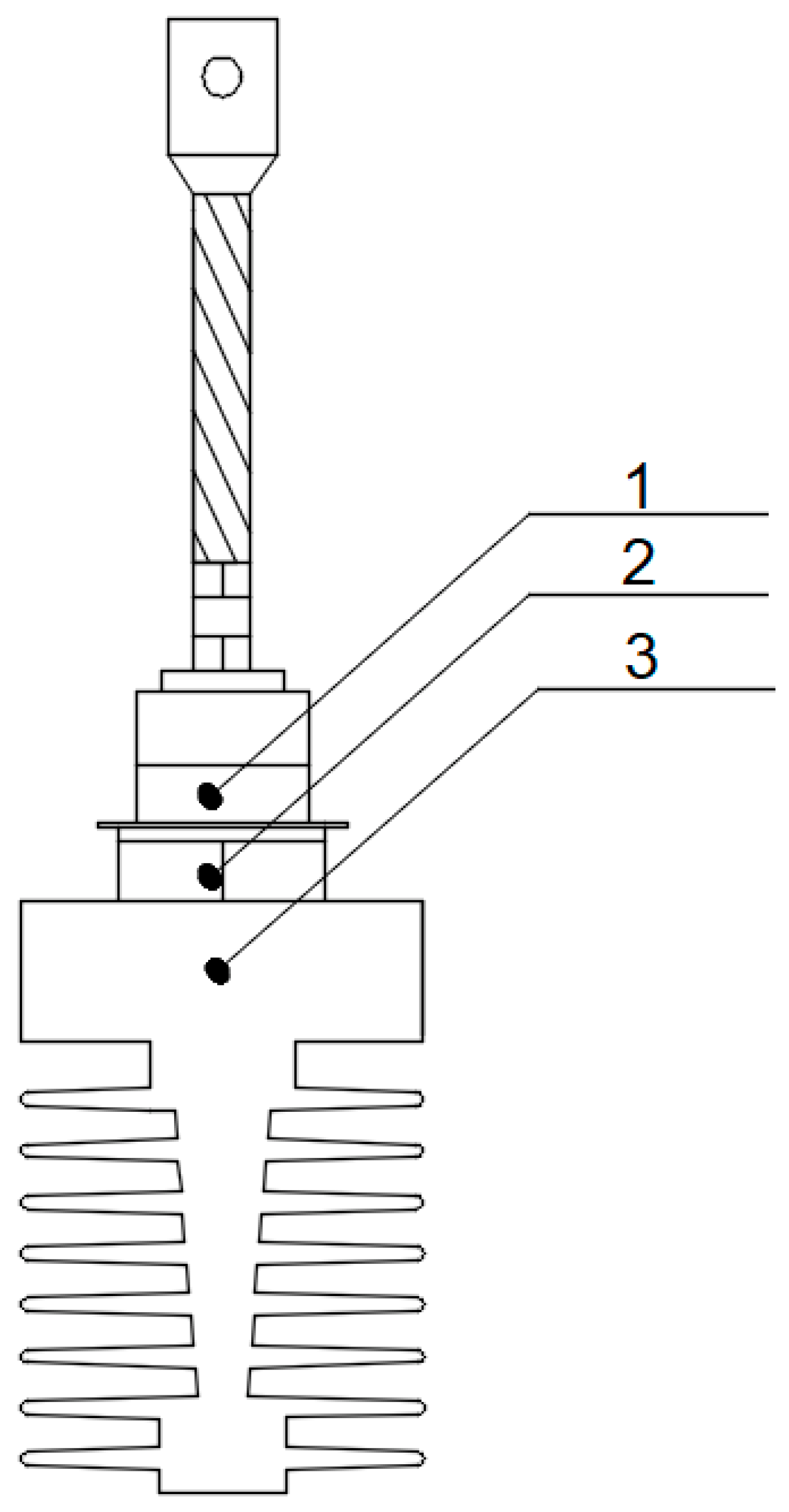



| Mesh Element Size (mm) | Tsym (°C) | Tc (°C) | Duration of the Simulation (s) |
|---|---|---|---|
| 1.0 | 63.2 | 64.5 | 980 |
| 2.5 | 63.1 | 64.5 | 280 |
| 5.0 | 51.5 | 64.5 | 12 |
| No. | Material | k (W/(m·K)) |
|---|---|---|
| 1 | Cast steel | 80 |
| 2 | Cast steel | 80 |
| 3 | Aluminum | 100 |
| 4 | Epoxy | 0.2 |
| 5 | Aluminum | 100 |
| 6 | Silicon | 150 |
| 7 | Aluminum | 100 |
| 8 | Aluminum | 100 |
| 9 | Copper | 400 |
| 10 | Aluminum | 100 |
| 11 | Porcelain | 2.5 |
| The Number of the Measuring Point | hcr, hcf [W/(m2K)] | ||
|---|---|---|---|
| v = 0.75 m/s | v = 1.00 m/s | v = 1.50 m/s | |
| 3 | 63.2 | 64.5 | 980 |
| 4 | 63.1 | 64.5 | 280 |
| 5 | 51.5 | 64.5 | 12 |
| The Number of the Measuring Point | hcr, hcf [W/(m2K)] | ||
|---|---|---|---|
| v = 0.75 m/s | v = 1.00 m/s | v = 1.50 m/s | |
| 3 | 23.2 | 38.4 | 53.3 |
| 4 | 12.4 | 25.9 | 38.6 |
| 5 | 31.1 | 45.9 | 61.7 |
| The Number of the Measuring Point | hcr, hcf [W/(m2K)] | ||
|---|---|---|---|
| v = 0.75 m/s | v = 1.00 m/s | v = 1.50 m/s | |
| 3 | 38.6 | 58.4 | 79.1 |
| 4 | 27.7 | 46.9 | 67.6 |
| 5 | 36.7 | 56.9 | 76.7 |
| No. | Pj (W) | Measurement Point Number | v (m/s) | Tsym (°C) | Tc (°C) | Tc − Tsym (°C) |
|---|---|---|---|---|---|---|
| 1 | 46.23 | 2 | 0.75 | 52.3 | 52.6 | 0.3 |
| 1 | 48.5 | 48.4 | −0.1 | |||
| 1.5 | 43.9 | 42.4 | −1.5 | |||
| 1 | 0.75 | 53.2 | 54.8 | 1.6 | ||
| 1 | 50.3 | 51.3 | 1.0 | |||
| 1.5 | 45.9 | 45.2 | −0.7 | |||
| 3 | 0.75 | 40.8 | 39.2 | −1.6 | ||
| 1 | 38.5 | 37.1 | −1.4 | |||
| 0.75 | 67.4 | 67.6 | 0.2 | |||
| 2 | 74.48 | 2 | 1 | 60.3 | 59.4 | −0.9 |
| 1.5 | 57.3 | 56.9 | −0.4 | |||
| 0.75 | 70.1 | 71.9 | 1.8 | |||
| 1 | 1 | 63.1 | 64.5 | 1.4 | ||
| 1.5 | 60.0 | 61.5 | 1.5 | |||
| 0.75 | 50.1 | 48.2 | −1.9 | |||
| 3 | 1 | 44.1 | 42.5 | −1.6 | ||
| 1.5 | 40.0 | 38.2 | −1.8 | |||
| 0.75 | 67.4 | 67.6 | 0.2 | |||
| 3 | 111.75 | 2 | 0.75 | 93.3 | 92.4 | −0.9 |
| 1 | 73.3 | 72.8 | −0.5 | |||
| 1.5 | 67.9 | 66.6 | −1.3 | |||
| 1 | 0.75 | 96.4 | 98.4 | 2.0 | ||
| 1 | 78.9 | 80.3 | 1.4 | |||
| 1.5 | 73.2 | 74.0 | 0.8 | |||
| 3 | 0.75 | 67.0 | 65.1 | −1.9 | ||
| 1 | 49.9 | 47.9 | −2.0 | |||
| 1.5 | 45.1 | 43.4 | −1.7 |
| No. | Pj (W) | v (m/s) | Tc (°C) | Tj (°C) | Tj − Tc (°C) |
|---|---|---|---|---|---|
| 1 | 46.23 | 0.75 | 52.6 | 56.3 | 3.7 |
| 1 | 48.4 | 53.5 | 5.1 | ||
| 1.5 | 42.4 | 50.8 | 8.4 | ||
| 0.75 | 54.8 | 56.3 | 1.5 | ||
| 1 | 51.3 | 53.5 | 2.2 | ||
| 1.5 | 45.2 | 50.8 | 5.6 | ||
| 0.75 | 39.2 | 56.3 | 17.1 | ||
| 1 | 37.1 | 53.5 | 16.4 | ||
| 1.5 | 33.3 | 50.8 | 17.5 | ||
| 2 | 74.48 | 0.75 | 67.6 | 77.5 | 9.9 |
| 1 | 59.4 | 70.5 | 11.1 | ||
| 1.5 | 56.9 | 67.4 | 10.5 | ||
| 0.75 | 71.9 | 77.5 | 5.6 | ||
| 1 | 64.5 | 70.5 | 6.0 | ||
| 1.5 | 61.5 | 67.4 | 5.9 | ||
| 0.75 | 48.2 | 77.5 | 29.3 | ||
| 1 | 42.5 | 70.5 | 28.0 | ||
| 1.5 | 38.2 | 67.4 | 29.2 | ||
| 3 | 111.75 | 0.75 | 92.4 | 107.5 | 15.1 |
| 1 | 72.8 | 91.2 | 18.4 | ||
| 1.5 | 66.6 | 86.4 | 19.8 | ||
| 0.75 | 98.4 | 107.5 | 9.1 | ||
| 1 | 80.3 | 91.2 | 10.9 | ||
| 1.5 | 74.0 | 86.4 | 12.4 | ||
| 0.75 | 65.1 | 107.5 | 42.4 | ||
| 1 | 47.9 | 91.2 | 43.3 | ||
| 1.5 | 43.4 | 86.4 | 43.0 |
Disclaimer/Publisher’s Note: The statements, opinions and data contained in all publications are solely those of the individual author(s) and contributor(s) and not of MDPI and/or the editor(s). MDPI and/or the editor(s) disclaim responsibility for any injury to people or property resulting from any ideas, methods, instructions or products referred to in the content. |
© 2023 by the authors. Licensee MDPI, Basel, Switzerland. This article is an open access article distributed under the terms and conditions of the Creative Commons Attribution (CC BY) license (https://creativecommons.org/licenses/by/4.0/).
Share and Cite
Dziarski, K.; Hulewicz, A.; Drużyński, Ł.; Dombek, G. Indirect Thermographic Temperature Measurement of a Power Rectifying Diode Die under Forced Convection Conditions. Appl. Sci. 2023, 13, 4440. https://doi.org/10.3390/app13074440
Dziarski K, Hulewicz A, Drużyński Ł, Dombek G. Indirect Thermographic Temperature Measurement of a Power Rectifying Diode Die under Forced Convection Conditions. Applied Sciences. 2023; 13(7):4440. https://doi.org/10.3390/app13074440
Chicago/Turabian StyleDziarski, Krzysztof, Arkadiusz Hulewicz, Łukasz Drużyński, and Grzegorz Dombek. 2023. "Indirect Thermographic Temperature Measurement of a Power Rectifying Diode Die under Forced Convection Conditions" Applied Sciences 13, no. 7: 4440. https://doi.org/10.3390/app13074440
APA StyleDziarski, K., Hulewicz, A., Drużyński, Ł., & Dombek, G. (2023). Indirect Thermographic Temperature Measurement of a Power Rectifying Diode Die under Forced Convection Conditions. Applied Sciences, 13(7), 4440. https://doi.org/10.3390/app13074440






